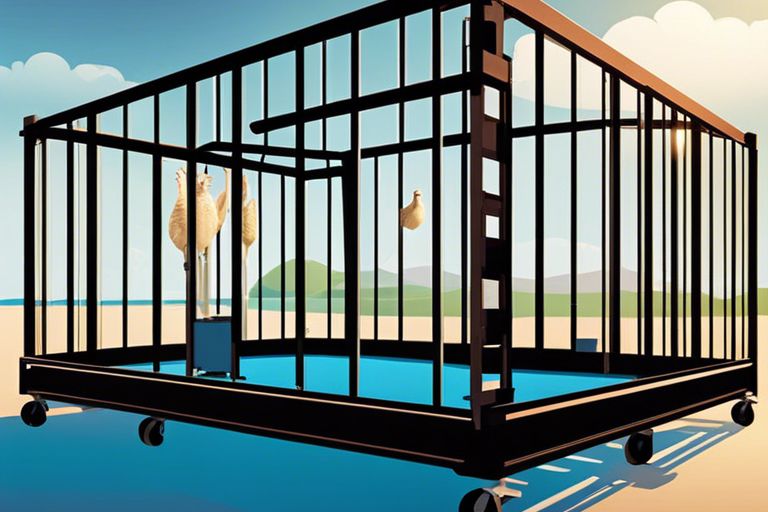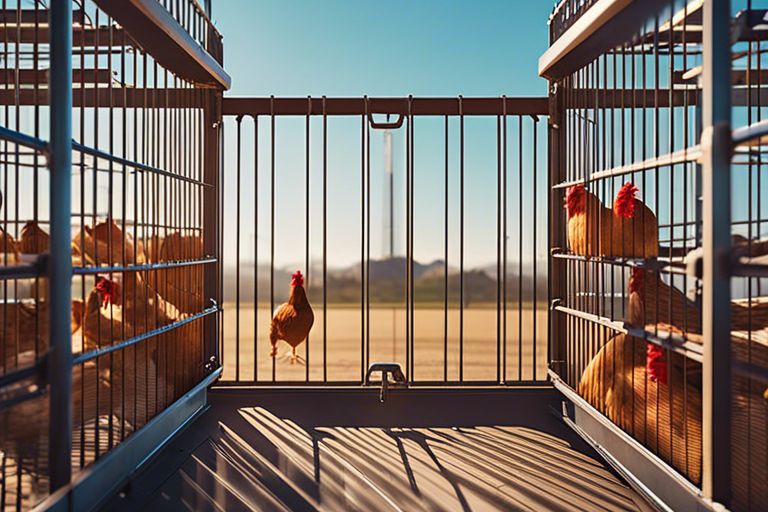NATIONAL EXHIBITION ON
ANIMAL HUSBANDRY, VETERINARY, FEED, EQUIPMENT & TECHNOLOGY
22, 23, 24 August 2024, BIEC, Bangalore, India


Just begining on the journey of setting up a poultry farm cage can be both exciting and overwhelming. From ensuring proper ventilation to maximizing space efficiency, every detail is crucial for the well-being of your feathered friends. In this comprehensive guide, we will walk you through the crucial steps and considerations to create a healthy and productive environment for your poultry farm.
The first step in setting up a poultry farm cage is determining the purpose and scope of your project. Are you planning to raise chickens for eggs, meat, or both? Understanding your goals will help you choose the right setup for your farm. Consider the size of the operation you want to start, as this will dictate how many cages you will need and the infrastructure required.
On researching local regulations and zoning laws, it is crucial to understand the regulations that govern poultry farming in your area. Zoning laws may restrict the location of your farm and the number of birds you can raise. By doing thorough research, you can ensure that your farm complies with all legal requirements and avoid potential issues down the line.
Purpose: Ensuring compliance with local regulations is important to avoid fines or closures that could jeopardize your poultry farm. By following these laws, you can protect the well-being of your birds and the success of your business.
1. Proper ventilation is crucial for cage hygiene and bird health.
2. Regular cleaning and disinfection prevent disease outbreaks.
3. Provide adequate space per bird for comfort and movement.
4. Ensure good lighting for egg production and bird well-being.
5. Monitor temperature levels for optimal bird growth.
6. Use quality feed and water sources for healthy poultry.
Some of the necessary decisions you will need to make when setting up a poultry farm revolve around the type of cage system you choose. Each system has its advantages and considerations, so it’s crucial to select the one that best suits your needs and the well-being of your birds.
One of the most common cage systems is the Battery Cage System, which allows for high-density housing and ease of management. On the other hand, Free-Range Systems provide birds with access to the outdoors, promoting natural behaviors but requiring more space. Hybrid Systems combine elements of both, offering a balance between confinement and freedom. This decision will significantly impact the health and productivity of your poultry flock, so it’s vital to weigh the pros and cons carefully.
| System Type | Description |
|---|---|
| Battery Cage System | High-density housing, easy management |
| Free-Range Systems | Outdoor access, natural behaviors |
| Hybrid Systems | Combination of both systems |
This choice will have long-term effects on your poultry farm’s efficiency and the well-being of your birds. Consider consulting with experts or experienced farmers to determine the best fit for your specific situation.
One crucial aspect to consider when choosing a cage system is the amount of space it provides for each bird. Overcrowding can lead to stress, aggression, and health issues, so ensuring adequate room for movement is necessary. Additionally, proper ventilation is vital to prevent the buildup of harmful gases and regulate temperature and humidity levels within the facility.
Assume that proper ventilation and sanitation are critical for preventing the spread of diseases and ensuring the overall health of your flock. It’s important to regularly clean and disinfect the cages to create a healthy environment for your birds.
Understanding the specific needs and behaviors of the poultry species you are raising is crucial to making informed decisions about cage systems. Consider factors such as space requirements, temperature preferences, and social dynamics within the flock to create a suitable and efficient environment for your birds. Paying attention to these details will lead to a successful poultry farming operation with healthy and productive birds.
Now, when setting up a poultry farm cage, one of the crucial decisions you’ll need to make is selecting the right breed of poultry for your farm. The choice of breed will depend on various factors such as egg production, meat production, and temperament. Each factor plays a significant role in determining which breed will be most suitable for your specific needs.
One key aspect to keep in mind is that certain breeds are dual-purpose, meaning they are suitable for both egg and meat production. Perceiving the main goal of your poultry farm will help narrow down your options and choose the breed that best aligns with your objectives.
Meat is an crucial component of the human diet, making poultry farming a lucrative endeavor for many farmers. Some popular breeds for small-scale poultry farming include Broilers, Rhode Island Reds, and Leghorns. These breeds are known for their fast growth rates, high meat yields, and adaptable nature to various farming environments.
Farming these popular breeds for small-scale poultry farming can be a rewarding experience, as they offer a balance of profitability and manageability. Additionally, these breeds are well-suited for beginners in the poultry farming industry, providing a good starting point for those looking to enter the market.
With the decision to set up a poultry farm cage, you will need a list of vital materials and tools to begin construction. The list typically includes wire mesh, wooden posts, hinges, nails, a hammer, pliers, and wire cutters. These items are crucial for building a sturdy and secure poultry farm cage that will provide a safe environment for your birds.
For ensuring that your poultry farm cage is built to last, consider these vital tips. First, make sure to use high-quality materials that can withstand various weather conditions and the pecking of the birds. Additionally, reinforce the corners and joints of the cage to prevent any weak spots that could lead to breakage or escape of the poultry. Thoroughly inspect the completed cage for any sharp edges or protruding wires that could harm the birds.
Building a poultry farm cage requires attention to detail and a focus on safety. Ensure that all materials are securely fastened, and there are no loose ends that could injure the birds. Additionally, provide adequate space for the poultry to move around comfortably inside the cage, promoting healthy growth and behavior. Though the process may be labor-intensive, the end result will be a secure and durable poultry farm cage that is vital for the well-being of your birds.

After setting up the framework of your poultry farm cage, the next crucial step is to install the vital equipment that will ensure the well-being of your birds and the efficiency of your operation. Let’s probe into the key equipment that you will need to set up in your poultry farm cage.
For efficient feeding and watering of your poultry, it is vital to invest in the right feeders and waterers. There are various types of feeders and waterers available in the market, including gravity-fed, automatic, and manual options. Gravity-fed feeders and waterers are ideal for large poultry flocks as they can hold a significant amount of feed and water, reducing the frequency of refills. Automatic feeders and waterers are convenient as they regulate the supply of feed and water, ensuring that your birds have access to fresh feed and water at all times.
| Types of Feeders | Types of Waterers |
| Gravity-fed | Gravity-fed |
| Automatic | Automatic |
| Manual | Manual |
The proper placement of feeders and waterers is crucial to ensure that all birds have easy access to feed and water. Position the feeders and waterers at a comfortable height for the birds to reach easily. Ensure that they are placed in areas of the cage where the birds can access them without hindrance. The efficiency of your poultry farm operation largely depends on the accessibility and functionality of these vital equipment. The health and productivity of your birds are directly influenced by their access to fresh feed and water.
For optimal egg production and bird comfort, it is vital to set up nesting boxes and roosting bars in your poultry farm cage. Nesting boxes provide hens with a designated space to lay their eggs, ensuring that the eggs are collected promptly and remain clean. Roosting bars allow the birds to perch comfortably at night, promoting natural roosting behavior and reducing stress.
Nesting boxes should be designed with adequate space and comfortable bedding to encourage hens to lay eggs consistently. The boxes should be placed in a quiet and secluded area of the cage to provide privacy to the hens. Roosting bars should be installed at a height where the birds feel safe and secure, away from potential predators. Proper design and installation of nesting boxes and roosting bars are vital for the overall well-being and productivity of your poultry flock.
Installing nesting boxes and roosting bars in your poultry farm cage is not only vital for the health and comfort of your birds but also contributes to the efficient operation of your farm. By providing your birds with suitable nesting and roosting spaces, you are creating an environment that promotes natural behavior and reduces stress. This, in turn, leads to improved egg production, better bird health, and overall success in your poultry farming endeavors.
For successful poultry farm management, vaccination and disease prevention strategies are crucial. Vaccinating your poultry against common diseases like Newcastle disease, infectious bronchitis, and Marek’s disease can significantly reduce the risk of illness among your flock. Consult with a veterinarian to create a targeted vaccination schedule based on the specific needs of your birds and the prevalent diseases in your area.
Additionally, implementing biosecurity measures such as limiting visitors, quarantining new birds, and keeping the farm clean can help prevent the spread of diseases. Regularly monitoring your flock for any signs of illness and promptly isolating sick birds can further protect the overall health of your poultry.
Managing the cleanliness of the poultry farm cage and equipment is important for maintaining a healthy environment for your birds. The cage should be cleaned regularly to remove waste and debris, reducing the risk of bacterial growth and disease transmission. Equipment such as feeders and waterers should also be cleaned and sanitized to prevent contamination.
Regularly disinfecting the cage and equipment using a poultry-safe disinfectant can help kill harmful bacteria and parasites, promoting a hygienic living space for your birds. Proper cleaning and disinfection practices can prevent the buildup of pathogens and improve the overall health and well-being of your flock.
So, setting up a poultry farm cage is a practical and beneficial step towards efficient poultry farming. By following the guidelines outlined in this article, farmers can ensure the well-being and productivity of their poultry flock. Remember to prioritize the comfort, safety, and health of the birds when designing and maintaining the cages. With proper care and attention, a poultry farm cage can be a vital component of a successful poultry farming operation.
A: Setting up a poultry farm cage is important because it provides a controlled environment for the birds, ensuring their safety and well-being. It also helps in efficient management of the flock, feeding, and egg collection.
A: The key components needed to set up a poultry farm cage include sturdy cage structures, proper ventilation system, feeding and watering systems, nesting boxes, and adequate lighting.
A: To ensure hygiene and cleanliness in the poultry farm cage, regular cleaning and disinfection of the cage and surrounding areas are necessary. Proper waste management, providing clean bedding material, and monitoring the health of the birds can also contribute to maintaining a healthy environment.